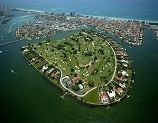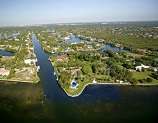Beyond Curb Appeal: Take a Closer Look at a Home’s Landscape
By Amy Hoak, MarketWatch
RISMEDIA, August 1, 2007—(MarketWatch)—An infestation of carpenter ants signaled the demise of a shade tree in Doug Cowles’ yard almost 20 years ago when he lived in Downers Grove, Ill. In retrospect, he knows he should have given the trees a better look before buying the home.
“I had to pay to lose my shade,” Cowles said. “Once it was gone, the deck wasn’t as useful an asset to the property — or as nice to enjoy.”
Any real estate agent will stress the importance of curb appeal,
a home’s first chance at a good impression based on how it looks
from the street. And from a seller’s perspective, a lush green
lawn and manicured shrubs can do wonders in wooing a prospective buyer.
But buyers shouldn’t get swept off their feet too quickly, charmed
by landscaping detail or the welcoming shade of a mature tree.
“Try to get away from the paint and how pretty the landscaping is,” said Frank Lesh, president of the American Society of Home Inspectors, as well as an Indian Head Park, Ill.-based inspector. Instead, pay attention to how these outdoor elements are functioning, noticing, for example, the health of the property’s plants, how their placement could affect the home and the overall slope of the lawn, he said.
Valuing curb appeal
Consumers often perceive value in a home’s landscaping at first
glance, and a 2005 study by the Department of Horticulture at Michigan
State University showed evidence of that.
The study presented participants in seven different markets with multiple
pictures of the same home. One image had only a lawn and cement sidewalk
and driveway in front of the home; others imposed various landscaping
schemes, said Bridget Behe, one of the researchers and a professor
of horticulture at Michigan State.
The overall finding: Value increased from 5% to 11% for homes with good landscaping. The elements most important to participants were those that displayed some design sophistication, such as curving flower beds instead of rectangular boxes against the home.
The next most important element was plant size, followed by the diversity of plant material in front of a home, according to the study.
Enhancing an average home with eye-catching landscaping is “like putting a nicer frame on a modestly priced painting,” Behe said. “It enhances the perceived value of that home.”
To identify exactly how much landscaping elements are worth, some higher-end home sellers are paying several hundred dollars for a service to profile — and assign a value to — the plants in their yards. Cowles, the homeowner who had the misfortune of losing his tree to carpenter ants, is the president and CEO of Horticultural Asset Management, Inc., a Cary, N.C.-based company that assesses a property’s plants for both insurance and real-estate purposes.
The company aims to help quantify the curb appeal of a property, Cowles said. Using the assessment, a prospective buyer can consider during negotiations the value of a property’s mature trees, many of which could cost $25,000 to $30,000 each to replace, he said.
“In this way, we help a property owner who may have a lot of plants, high quality plants or mature landscaping create a competitive advantage against other properties with fewer, lesser quality or smaller plants,” he said in an e-mail.
What to look for
The seller of a median-priced home likely won’t spring for a thorough evaluation of trees. Instead, as a buyer nears the closing table, a home inspector will probably evaluate outdoor elements to make sure conditions won’t cause problems tomorrow.
Before seriously considering a property, however, it might be a good idea for a buyer to look over a home’s exterior. He or she might make mental notes of minor issues, but larger ones that need to be taken care of — such as the removal of a tree or large limbs — could be discussed in the negotiation process, Lesh said.
Here are some tips on what to look for:
- Plant health. Even if you’re not an arborist, there are some
telltale signs that a plant is sick. Wilting plants or brown and crispy
leaves are warning signs that a plant might not be in good health,
Behe said. Mushrooms and fungus at the bottom of a tree are also warning
signs, added Cowles, who would also advise looking for evidence of
insect problems.
- Placement of tree limbs. Look to see if any limbs are touching a
roof or could interfere with a power line — both possible areas
of concern. But be especially aware of a tree limb hanging over the
chimney, Lesh said. Not only could animals climb down into the chimney,
but a blocking branch could affect the draft and create higher carbon
monoxide levels in the home.
- Problems underground. It’s tougher to look for evidence of
heavy root growth than it is to take a survey of the limbs above.
But sometimes roots will make their presence known by lifting or cracking
a sidewalk or driveway, creating a trip hazard, Lesh said. Also, a
depression in the yard could indicate a leaking sewer line as a result
of root interference, and may need to be checked further, he added.
- The lay of the land. Take a drive around the block and get a good
look at the ground the home is on, Lesh said. Is it at the bottom
of the hillside, at the top of one, or on flat land? It’s important
that rain isn’t able to follow a downward slope toward the foundation,
a condition that could lead to flooding.
- Foliage proximity. Watch out for foliage that is close to the house’s
exterior, Lesh said, because that can provide shelter for insects
and rodents that allow them to hide from their predators — and
give them an excellent vantage point to enter the house. Also, if
shrubs are too close to the building and the wind causes them to rub
up against the house, the siding could wear out as a result. “The
plants will grow back next year, the house will not,” Lesh said.
- Deck construction. While a deck isn’t a living part of the
landscape, it’s still an important one to inspect. The building
of a deck is a common do-it-yourself project, and sometimes novice
mistakes can be found in the final product, Lesh said. Make sure that
the deck is fastened to the house correctly and is supported properly.
They should have places for people to grab onto, he said, and balusters
should be close enough that a 4-inch ball couldn’t fit through
them (ensuring that a child’s head couldn’t get stuck).
Amy Hoak is a MarketWatch reporter based in Chicago.











